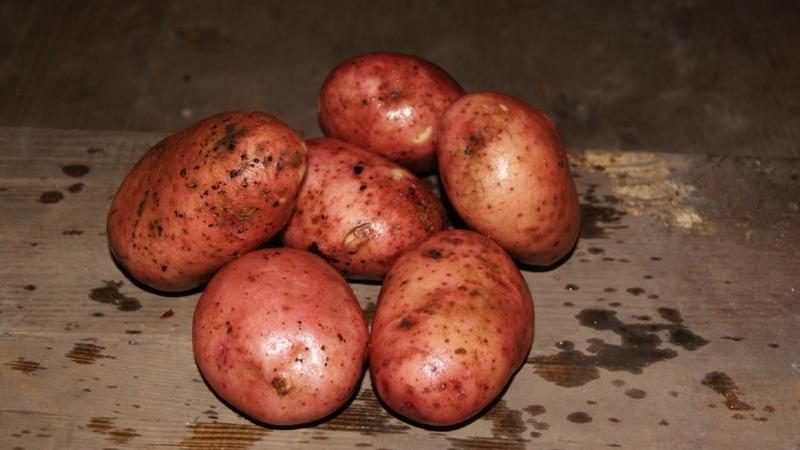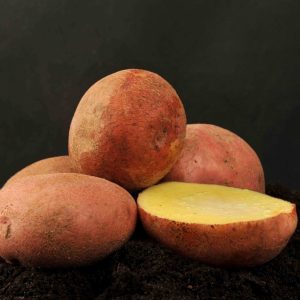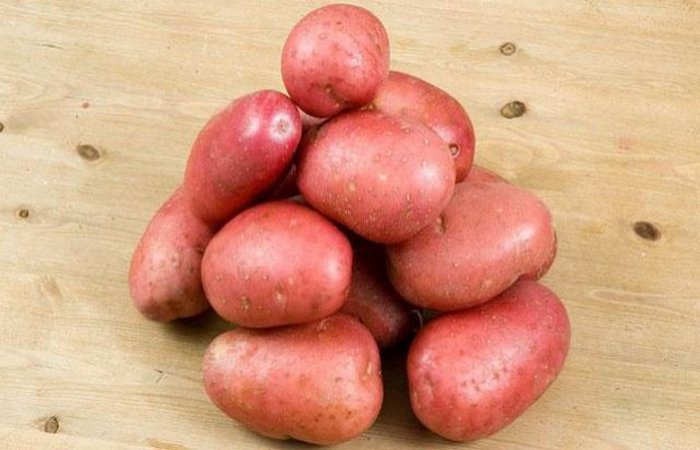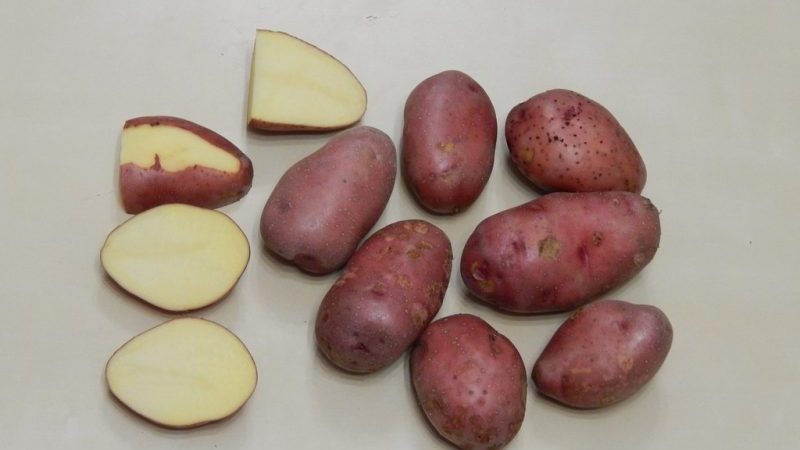High-yielding, frost-resistant potato variety "Zhuravinka" with excellent taste
Zhuravinka potatoes are bred in Belarus and are not much inferior to their Dutch counterparts. All characteristics of the variety comply with international standards. Many summer residents love it for its high yield, excellent taste and good keeping quality.
The content of the article
Description of the variety, origin and development
Zhuravinka is a mid-late variety of table potatoes.
Russian and Belarusian breeders worked on breeding the variety. In 2005, the variety was included in the State Register of Russia. The patent was issued by the Belarusian RUE SPC NAS.

Chemical composition, trace elements and vitamins
The energy value of potatoes per 100 g is 73 kcal.
Nutritional value per 100 g:
- water - 80 g;
- proteins - 1.9 g;
- fats - 0.1 g;

- carbohydrates - 16.6 g;
Potatoes contain 19% starch.
Chemical composition per 100 g:
- vitamin B1 - 0.08 mg;
- vitamin B2 - 0.03 mg;
- vitamin B3 - 1.1 mg;
- vitamin B6 - 0.24 mg;
- vitamin B9 - 16.5 mcg;
- vitamin C - 11 mg;
- calcium - 11 mg;
- magnesium - 22 mg;
- phosphorus - 59 mg;
- potassium - 426 mg;
- lutein - 13 mcg;
The tubers contain amino acids and saturated fatty acids. In small quantities, the vegetable contains monounsaturated and polyunsaturated fatty acids.
Ripening period and yield
Zhuravinka potatoes ripen 100-110 days after germination. In warm regions, the ripening of the vegetable is possible after 90 days.
From 1 hectare, 500-600 centners of potatoes are obtained, sometimes the figure reaches 700 centners.
Reference. 15-20 medium and large tubers are dug from one bush.
Gardeners owning small plots, from 1 m² of plantings, harvest 7-8 kg of potatoes.
Disease resistance
The variety has a strong immunity to golden nematode and potato crayfish... Resistant to scab, black leg and late blight of tubers. But Zhuravinka has low resistance to rhizoctonia and late blight of the terrestrial part.
Characteristics of tubers, description of appearance

Features of tubers:
- the shape is oval-round or round;
- the surface of the tuber is smooth or embossed, covered with a kind of mesh;
- the peel is reddish, the flesh is light yellow;
- eyes are small, evenly distributed over the surface;
- weight 120-180 g, but there are large specimens up to 300 g;
Potato bushes up to 50 cm high. Stems 0.6-1 cm thick. Leaves are rounded, dark green, the central vein is darker, the edges are wavy.
The inflorescences are small in size and consist of 6-7 flowers of a reddish-purple or purple hue. Berries are rare.
Growing region
The variety is recommended for cultivation in the North-West, Central and Volga-Vyatka regions. Summer residents cultivate it in other regions - from the Vologda region to the Perm region.
The main advantages and disadvantages of the variety
Zhuravinka has many advantages:
- great taste;
- fast cooking;
- high keeping rates;
- resistance to many potato diseases;
- good transportability;
- frost resistance;
- stable and high yield.
Minuses:
- long ripening of tubers;
- sensitivity to lack of moisture.
Features of planting and growing
When landing and growing, it is important to take into account the nuances in order to achieve the maximum yield.
Preparing for landing
To obtain friendly shoots, potato tubers are prepared in advance for planting:
- Germination. 4 weeks before planting, the tubers are sorted out and placed in a bright, warm room with a temperature of + 13 ... + 15 ° C.
- Landscaping. In order for solanine to form in seed tubers, they are kept in the sun for a week.
- Treatment with disinfectants... Before planting, the planting material is sprayed with the preparations Fitosporin, Maxim, Prestige to protect the plants from wireworm attacks, Colorado potato beetle and other pests.
After that, they begin to prepare the beds and plant potatoes.
Ground requirements
For planting, a sunny site is chosen where the groundwater is shallow.
Attention. After eggplants, peppers and tomatoes, potatoes are not planted on the site for at least 3 years.
It is not recommended to plant the crop in dry and hard soil - this will affect germination. And planting in too wet soil will lead to a complete loss of seedlings. The soil should be loose and nutritious.
Timing, scheme and landing rules
The Zhuravinka is planted when the air temperature rises to + 16 ... + 18 ° С, and the soil will be warmed up to +10 .. + 12 ° С.
In the northern regions, planting is carried out in the first decade of May. In the central regions - in late April or early May. And in the southern region - in mid-April.
Plant potatoes like this:
- Dig holes 15-20 cm deep. The planting pattern is standard. The distance between the rows is 70 cm, and between the bushes 30 cm.
- A handful of onion husks and wood ash are added to each hole.
- Seeds are laid with sprouts up.
- The holes are sprinkled with earth so that air flows to the roots.
The seeding depth depends on the soil: for light soil - 10 cm, and for clay soil - 7 cm.
Zhuravinka emerges amicably and immediately begins to grow intensively.
Growing recommendations
During the growth and development of the vegetable, follow the recommendations:
- The variety has a negative attitude to the excess of nitrogen fertilizers. Therefore, it is better to underfeed than overfeed.
- It is important to observe the required distance between the potato bushes, since each plant has many tubers and needs enough space for full development.
- During the period of growth and flowering, plantings need additional moisture. But at the same time, Zhuravinka does not tolerate waterlogging and with an excess of water begins to hurt. In a rainy summer, carry out preventive treatment of the bushes with Fundazol.
In general, potatoes respond well to mineral and organic additives. The variety is frost-resistant: if frosts occur after planting, the plants will not die.
The nuances of care
To form more large tubers, the variety needs proper care.
Watering mode
Zhuravinka's potatoes do not like prolonged drought. Therefore, in the absence of rain, plantings need watering. The amount of irrigation depends on the condition of the soil and the availability of rainfall.
During the period of intensive growth, it is recommended to water the beds weekly. But do not overmoisten - in damp soil there is a great risk of late blight.
Watering is carried out in the evening or morning hours. Calculation of water - 4-5 liters for each bush.
Top dressing
Feed culture is recommended according to the scheme:
- Before flowering... 1 tbsp. l. urea is diluted in 10 liters of water. 500 ml of solution is added under each bush.
- When forming buds. 1 tbsp. l. Mix "Superphosphate" and a glass of ash with 10 liters of water. One bush - 500 ml.
- During flowering. 1 tbsp. l. "Superphosphate" for 10 liters of water. Consumption per plant - 500 ml.
Strictly adhere to the recommended dosages to avoid excess nitrogen. Otherwise, the potatoes will stop growing, the formation of new tubers will not occur.
Weeding and hilling
When shoots appear, the soil is loosened, removing weeds, for better penetration of water and air to the roots. Loosening is then repeated as needed to prevent crust formation.
When the bushes grow 15-20 cm high, they are spud. For this, a small hill is made in the near-stem zone.
Important! In the northern regions, the soil is loosened 5-6 times during the growing season.
The second hilling is carried out after 20 days. This time usually corresponds to the flowering phase. The procedure is needed to prevent root disease, loosening the soil and killing weeds.
Disease and pest control
The variety is resistant to many potato diseases. However, a humid environment often causes late blight. At the first signs of the disease - spots on the leaves, plantings are treated with copper-containing preparations - Bordeaux liquid, copper oxychloride.
Of the pests, the Colorado potato beetle and wireworm are the most dangerous. But if other varieties of potatoes grow on the site, then the beetle does not sit on Zhuravinka.
Attention. Treatment of plants from pests with chemicals is carried out at least 30 days before the collection of tubers.
The fight against the Colorado potato beetle is carried out by collecting it by hand or using store-bought insecticides.
Harvesting and storage

You can start digging in the vegetable a little earlier. But for storage, wait until the tubers are fully ripe.
How and when to collect
Potatoes are harvested when the tops begin to dry out and turn yellow. Dig up the potatoes with a pitchfork or a shovel. This is done carefully so as not to damage the tubers.
Storage features and keeping quality of the variety
The harvested potatoes are dried for several hours in the beds, then sorted. Tubers selected for long-term storage are once again laid out to dry in a warm place where the sun's rays do not fall.
The vegetables can then be stored in a well-dried basement or cellar. The temperature there should be +3 .. + 4 ° С. The keeping quality of the variety is 96%.
Growing difficulties
During the care of Zhuravinka potatoes, some problems may arise:
- the variety does not tolerate waterlogged soil, but drought also negatively affects the harvest;
- fertilizer must be applied correctly in order to prevent an excess of nitrogen;
Periodically, it is worth checking the plantings for the presence of Colorado beetles, otherwise the entire crop may die.
Tips from experienced gardeners and reviews about the Zhuravinka variety
Many summer residents advise to dig up the plot in the fall and add a bucket of rotted manure, 10 g of "Superphosphate" and a glass of wood ash - dosage per 1 m² of the plot. In the spring the land is plowed again, but without fertilizers.
To combat Colorado beetles, odorous plants are planted next to potato bushes.
Reviews of the Zhuravinka variety are mostly good. Many people like the taste and bountiful harvest. However, summer residents note the exactingness of potatoes for care. Gardeners sometimes call this potato variety Zhuravushka.
Vasily, Perm: «I planted this variety on my site and began to notice that it is rather capricious in its care. In order for the bushes to grow well, several times I had to make additional fertilizing with minerals and organic matter. However, it tastes good. "
Natalia, Moscow: “I would like to note the excellent taste of Zhuravushka potatoes. Children love her. Puree is prepared without unnecessary manipulations, it turns out without lumps and perfect color. "
Lida, Barnaul: “The variety turned out to be very productive. I ran into him by accident. I read a description of the Zhuravinka potato variety on the Internet, saw a photo of the crop. Compared to other varieties, Zhuravinka has the most tubers from one bush. "
Conclusion
Due to the abundant harvest and immunity to diseases, Zhuravinka's potatoes have become popular not only in Russia, but also in neighboring countries. The sprouts on the tubers are strong and sprout quickly. Many gardeners note that even with frosts, the yield percentage remains.